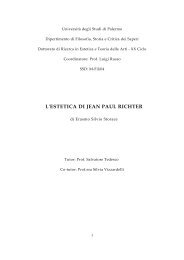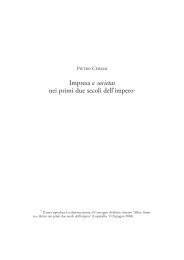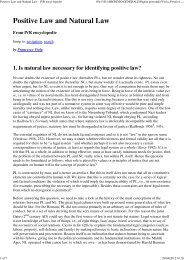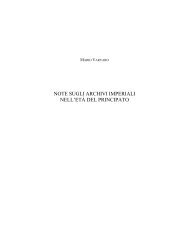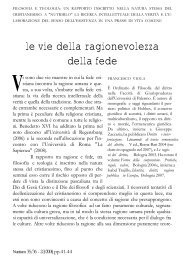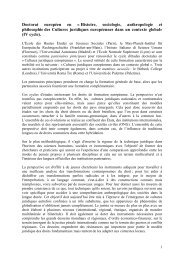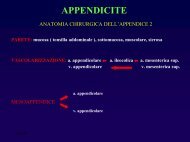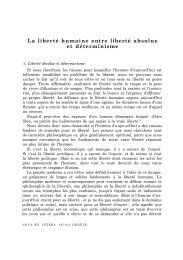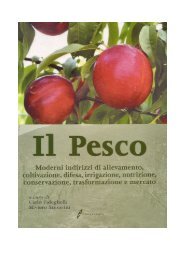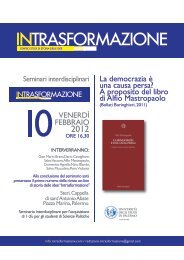M. VARVARO, Gai 4.163 e la struttura della formula arbitraria nell ...
M. VARVARO, Gai 4.163 e la struttura della formula arbitraria nell ...
M. VARVARO, Gai 4.163 e la struttura della formula arbitraria nell ...
You also want an ePaper? Increase the reach of your titles
YUMPU automatically turns print PDFs into web optimized ePapers that Google loves.
M. Varvaro, <strong>Gai</strong> <strong>4.163</strong> e <strong>la</strong> <strong>struttura</strong> del<strong>la</strong> formu<strong>la</strong> <strong>arbitraria</strong> [p. 705-734]<br />
1. Secondo l’opinione oggi prevalente nel<strong>la</strong> storiografia, gli interdicta<br />
erano ordini magistratuali, positivi o negativi, subordinati al<strong>la</strong><br />
esistenza di determinati presupposti. Se l’intimato avesse ottemperato<br />
all’ordine, senza mettere in discussione l’esistenza di tali presupposti,<br />
il procedimento si sarebbe immediatamente concluso. Questo esito sarebbe<br />
stato conforme allo scopo, proprio degli interdetti, di porre fine<br />
a una controversia. 1 Diversamente, si sarebbe potuto instaurare un<br />
apposito procedimento, nel corso del quale sarebbe stata accertata <strong>la</strong><br />
sussistenza di tali presupposti. 2 Al riguardo si è soliti discorrere di agere<br />
ex interdicto. 3<br />
—————————<br />
1 Cfr. <strong>Gai</strong> 4.139 [KRUEGER-STUDEMUND 7 , 191]: Certis igitur ex causis praetor aut<br />
proconsul principaliter auctoritatem suam finiendis controuersiis interponit. Nel<strong>la</strong> letteratura<br />
più recente possono vedersi al riguardo le osservazioni di G. NICOSIA, Nuovi<br />
profili istituzionali essenziali di diritto romano 5 , Catania 2010, 139 s.<br />
2 Sul<strong>la</strong> questione re<strong>la</strong>tiva all’esito eventuale o necessario del procedimento di accertamento<br />
dei presupposti dell’interdetto v. da ultimo G. FALCONE, Appunti sul IV<br />
commentario delle Istituzioni di <strong>Gai</strong>o, Torino 2003, 131-140, con richiami bibliografici<br />
al<strong>la</strong> nt. 278.<br />
3 Sull’agere ex interdicto v., fra i tanti, CHR.G. HAUBOLD, Ueber die Stelle von den<br />
Interdicten in den Veronesischen Handschriften, in ZgRW 3, 1817, 379-388; S.W. ZIM-<br />
MERN, Der römische Zivilprozeß in geschichtlicher Entwicklung bis auf Justinian, III,<br />
Heidelberg 1829, 220-223; W.B. LEIST, Die Bonorum possessio. Ihre geschichtliche Entwicklung<br />
und heutige Geltung, I, Göttingen 1844, 340-356; F. WALTER, Geschichte des<br />
römischen Rechts bis auf Justinian, II 2 , Bonn 1846, 382 s.; K.A. SCHMIDT, Das Interdiktenverfahren<br />
der Römer. In geschichtlicher Entwickelung, Leipzig 1853, 253 ss.; M.A.<br />
VON BETHMANN-HOLLWEG, Der römische Civilprozess, II. Formu<strong>la</strong>e, Bonn 1865, 363 ss.;<br />
G.F. PUCHTA, Cursus der Institutionen, II 7 , Leipzig 1871, 135-140; F.L. VON KELLER-A.<br />
WACH, Der römische Civilprocess und die Actionen in summarischer Darstellung zum<br />
Gebrauche bei Vorlesungen 6 , Leipzig 1993, 380-383; E. PFERSCHE, Die Interdicte des<br />
römischen Civilprocesses. Eine rechtsgeschichtliche Untersuchung, Graz 1888, 93 ss.; A.<br />
UBBELOHDE, in F. GLÜCK (a cura di), Commentario alle Pandette tradotto e arricchito di<br />
copiose note e confronti col codice civile del Regno d’Italia, XLIII-XLIV, Parte I e II, trad. e<br />
note di V. Pouchain, Mi<strong>la</strong>no 1899, 459-618; P.F. GIRARD, Manuale elementare di diritto<br />
romano 4 , trad. ital. di C. Longo, Mi<strong>la</strong>no 1909, 1070-1075; A. BERGER, v. ‘Interdictum ’,<br />
in PWRE IX, Stuttgart 1916, 1693-1699; L. WENGER, Institutionen des römischen<br />
Zivilprozessrechts, München 1925, 238-241; O. LENEL, Das Edictum Perpetuum. Ein<br />
Versuch zu seiner Wiederherstellung 3 , Leipzig 1927 (d’ora innanzi: EP 3 ), 447-452; G.<br />
GANDOLFI, Contributo allo studio del processo interdittale romano, Mi<strong>la</strong>no 1955, 110-115;<br />
A. BISCARDI, La tute<strong>la</strong> interdittale ed il re<strong>la</strong>tivo processo, Siena 1956, ripubbl. con una nota<br />
di lettura di R. MARTINI in RDR 2, 2002, 62-68; J. IGLESIAS, Derecho romano.<br />
Instituciones de derecho privado 6 , Barcelona 1958, 217 s.; G.I. LUZZATTO, Il problema<br />
d’origine del processo extra ordinem, I. Premesse di metodo. I cosiddetti rimedi pretori,<br />
Bologna 1965, 155 ss.; L. CAPOGROSSI COLOGNESI, v. ‘Interdetti ’, in Enc. dir. 21,<br />
AUPA 55/2012 707



